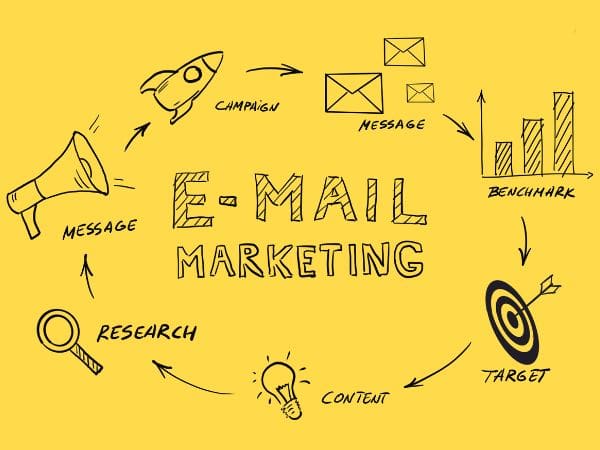If you’re looking for a way to grow your online business, email marketing is one strategy you can’t afford to ignore. Email marketing is a form of digital marketing that involves sending emails to a group of people in order to promote your products or services, build relationships with your audience, and ultimately drive sales.
Why does email marketing matter? Because it’s one of the most effective ways to reach your target audience and build a relationship with them. According to recent research, email marketing has an average return on investment (ROI) of 42:1. That means for every dollar you spend on email marketing, you can expect to see $42 in revenue. I am not sure about you but those are statistics I like.
But what exactly is email marketing, and how does it work?
What is Email Marketing?
Email marketing is the process of sending commercial messages to a group of people via email. These messages can take many forms, from promotional offers to newsletters to announcements about new products or services.
The goal of email marketing is to build a relationship with your audience and keep them engaged with your brand over time. By sending regular emails, you can stay top-of-mind with your audience, provide them with valuable content, and ultimately drive sales.

How Does Email Marketing Work?
To get started with email marketing, you’ll need a list of email subscribers. These are people who have given you permission to send them emails by signing up for your newsletter, downloading a lead magnet, or making a purchase from your website.
Once you have a list of subscribers, you can start sending them emails. There are many different types of emails you can send, including:
- Promotional Emails: These emails promote a specific product or service, and often include a special offer or discount code to encourage subscribers to make a purchase.
- Newsletter Emails: These emails provide subscribers with updates about your brand, industry news, and other relevant content. Newsletter emails are a great way to keep your audience engaged with your brand over time.
- Welcome Emails: These emails are sent to new subscribers to welcome them to your list and provide them with information about your brand and what they can expect from your emails.
- Abandoned Cart Emails: These emails are sent to people who have added items to their cart on your website but haven’t completed their purchase. Abandoned cart emails can be very effective at driving sales and recovering lost revenue.
When you send an email, you’ll want to make sure it’s engaging, informative, and relevant to your audience. You can use tools like personalization, segmentation, and automation to make your emails more targeted and effective.
Personalization involves using your subscribers’ names, locations, and other data to make your emails feel more personalised and relevant to them. Segmentation involves dividing your list into different groups based on characteristics like interests, behaviours, and demographics. By segmenting your list, you can send more targeted emails that are more likely to resonate with each group.
Automation involves setting up triggers and workflows that automatically send emails based on certain actions or behaviours. For example, you could set up an automation that sends a welcome email to new subscribers as soon as they sign up for your list, or an abandoned cart email to people who leave items in their cart but don’t complete their purchase.
Most email marketing platforms that are good, will have these tools available.
Why is Email Marketing important?
Email marketing is a powerful tool for online businesses. It’s a cost-effective way to reach your target audience, build relationships with your customers, and ultimately drive sales. Let’s explore some of the reasons why email marketing is so important and why it’s a must for any online business.
Reach Your Target Audience.
One of the biggest benefits of email marketing is that it allows you to reach your target audience directly. Unlike other forms of digital marketing, where you’re competing for attention on social media or search engines, email marketing allows you to communicate with your subscribers directly in their inbox.
When someone signs up for your email list, they’re expressing interest in your brand and giving you permission to contact them. This means that the people on your email list are already interested in what you have to offer, making them more likely to engage with your emails and ultimately make a purchase.
Build Relationships with Your Customers
Email marketing is also a powerful tool for building relationships with your customers. As I mentioned earlier, by sending regular emails, you can stay top-of-mind with your audience and provide them with valuable content that keeps them engaged with your brand.
Whether you’re sending newsletters, promotional emails, or abandoned cart reminders, each email is an opportunity to provide value to your subscribers and build trust with them over time. By building relationships with your customers, you can turn them into loyal brand advocates who will not only make repeat purchases but also refer your brand to others.
Drive Sales and Revenue
Of course, one of the main goals of email marketing is to drive sales and revenue. By sending promotional emails and special offers, you can incentivize your subscribers to make a purchase or take advantage of a limited-time deal.
Increase Website Traffic
Email marketing is also a great way to increase traffic to your website. By including links to your website in your emails, you can encourage subscribers to click through and visit your site.
This can be particularly effective if you’re promoting a new product or service, as you can use your emails to drive traffic to a dedicated landing page that’s optimised for conversions.
Measure and Improve Results
Another reason why email marketing is important is that it’s highly measurable. Most email marketing platforms provide detailed analytics that allow you to track opens, clicks, and conversions for each email you send.
By tracking these metrics, you can see what’s working and what’s not and make adjustments to your email strategy accordingly. For example, if you notice that certain types of emails are getting a high open rate but a low click-through rate, you can experiment with different subject lines or calls-to-action to improve your results.
Cost-Effective Marketing
Finally, email marketing is a cost-effective way to reach your target audience and drive sales. Unlike other forms of digital marketing, like paid advertising or influencer marketing, email marketing doesn’t require a significant investment upfront.
Most email marketing platforms offer a variety of pricing plans, including free plans for businesses with smaller email lists. This makes email marketing accessible to businesses of all sizes, regardless of their marketing budget.
How to Get Started with Email Marketing
Email marketing is a powerful tool for online businesses, but if you’re new to it, it can seem overwhelming. Not to worry, I’ll walk you through the steps you need to take to get started with email marketing, from building your email list to creating your first campaign.

Step 1: Choose an Email Marketing Platform
The first step in getting started with email marketing is to choose an email marketing platform. There are a variety of options available, each with its own set of features and pricing plans.
Some popular email marketing platforms include Mailchimp, Constant Contact, and ConvertKit. When choosing a platform, consider your budget, the size of your email list, and the features you need, such as automation and segmentation.
Some of the email marketing platforms that I do recommend are;
Step 2: Build Your Email List
Once you’ve chosen an email marketing platform, the next step is to build your email list. Your email list is made up of people who have given you permission to contact them via email, usually by subscribing to your website or opting in to a lead magnet.
To build your email list, you can use a variety of tactics, including:
- Adding an opt-in form to your website
- Offering a lead magnet in exchange for email addresses
- Running social media ads that drive traffic to a landing page with an opt-in form
When building your email list, it’s important to ensure that you’re collecting permission-based email addresses and following email marketing best practices to avoid spamming or irritating your subscribers.
Step 3: Segment Your Email List
Once you’ve built your email list, it’s important to segment it based on factors such as demographics, behaviour, and interests. By segmenting your list, you can send targeted emails that are more likely to resonate with your subscribers and drive engagement.
For example, if you run an online store that sells clothing for both men and women, you could segment your list based on gender and send targeted emails that feature products that are specific to each audience.
Step 4: Create Your First Campaign
With your email list and segmentation in place, it’s time to create your first email campaign. Your campaign should have a clear goal, whether that’s to drive sales, build brand awareness, or provide value to your subscribers.
When creating your campaign, consider the following elements:
- Subject line: Your subject line is the first thing your subscribers will see in their inbox, so make sure it’s attention-grabbing and relevant to the content of your email.
- Content: Your email content should provide value to your subscribers, whether that’s in the form of a special offer, helpful tips, or entertaining content.
- Call-to-action: Your email should have a clear call-to-action (CTA) that encourages your subscribers to take a specific action, such as making a purchase or visiting your website.
- Design: Your email design should be visually appealing and easy to read on both desktop and mobile devices. The email marketing platforms I listed above offer well designed, effective templates for you to make this easy.
Step 5: Test and Refine Your Campaigns
After you’ve sent your first email campaign, it’s important to test and refine your approach based on the results. Most email marketing platforms offer detailed analytics that allow you to see how your campaigns are performing, including open rates, click-through rates, and conversions.
By analysing these metrics, you can identify what’s working and what’s not and make adjustments to your approach. For example, if you notice that your open rates are low, you could experiment with different subject lines to see if that improves your results.
Step 6: Use Automation to Streamline Your Approach
As your email list grows and your campaigns become more complex, it can be helpful to use automation to streamline your approach. Email automation allows you to send targeted emails based on specific triggers or actions taken by your subscribers, such as signing up for a webinar or abandoning their shopping cart.
Popular automation workflows include welcome sequences, abandoned cart reminders, and post-purchase follow-ups.
To set up automation workflows, you’ll need to create a series of emails that are triggered by specific actions or behaviours. For example, a welcome sequence could include a series of emails that are sent to new subscribers over the course of a week, each with a specific goal, such as introducing your brand, providing value, and encouraging engagement.
Step 7: Stay Compliant with Email Marketing Regulations
As with any marketing channel, it’s important to stay compliant with email marketing regulations to avoid legal issues and maintain the trust of your subscribers.
In the United States, the primary email marketing regulation is the CAN-SPAM Act, which requires that commercial emails include a clear opt-out mechanism, a valid physical address, and accurate header information.
Other regulations to consider include GDPR (General Data Protection Regulation) and CASL (Canadian Anti-Spam Legislation).
Step 8: Continuously Improve Your Strategy
Finally, it’s important to continuously improve your email marketing strategy over time. This means regularly analysing your results, testing new approaches, and staying up-to-date on industry trends and best practices.
To improve your strategy, consider the following tactics:
- A/B testing: Test different elements of your emails, such as subject lines, content, and calls-to-action, to see what performs best.
- Personalization: Use data to personalise your emails based on the preferences and behaviours of your subscribers.
- List hygiene: Regularly clean your email list by removing inactive subscribers or those who have unsubscribed to maintain a high-quality list.
- Mobile optimization: Ensure that your emails are optimised for mobile devices, as more than half of all emails are opened on mobile devices.
By continuously improving your email marketing strategy, you can drive more engagement, build stronger relationships with your subscribers, and ultimately grow your business.

Avoid These Common Mistakes in Email Marketing
Email marketing is a powerful tool for online businesses, but it’s important to approach it with strategy and care. While effective email marketing can help you build relationships with your audience and drive sales, there are several common mistakes that can hinder your success. In this article, we’ll explore some of these mistakes and provide tips on how to avoid them.
Neglecting Permission-Based Marketing
One of the biggest mistakes in email marketing is neglecting to obtain proper permission from your subscribers. It’s crucial to ensure that every subscriber on your email list has explicitly given you permission to contact them. Sending emails to people who haven’t opted in or purchased from you can lead to spam complaints and damage your reputation.
To avoid this mistake, implement permission-based marketing practices. Use double opt-ins, where subscribers confirm their subscription via email, to ensure that they willingly signed up for your emails. Respect your subscribers’ preferences and provide clear and easy-to-find options for opting out of your emails.
Failing to Segment Your Email List
Another common mistake is sending the same email to your entire list, without considering the diverse interests and preferences of your subscribers. Failing to segment your email list can result in generic, irrelevant content that fails to engage your audience.
Segmentation is key to delivering targeted and personalised emails. Divide your email list into smaller groups based on factors like demographics, past purchases, or engagement level. This allows you to create more relevant content and offers that resonate with each segment. Utilise the data you collect to tailor your emails, increase open and click-through rates, and drive conversions.
Overwhelming Subscribers with Excessive Emails
Sending too many emails is a surefire way to annoy your subscribers and prompt them to hit the unsubscribe button. Bombarding your audience with excessive emails can lead to fatigue, disengagement, and ultimately, loss of subscribers.
Find the right frequency for sending emails that works for your audience. Consider factors like the nature of your business and the expectations set when subscribers signed up. Balance regular communication with giving your audience enough time to digest your content and not feel overwhelmed. Monitor email engagement metrics to determine if the frequency needs adjustment.
Neglecting Mobile Optimization
With the majority of emails being opened on mobile devices, neglecting mobile optimization is a grave mistake. If your emails don’t display properly or are difficult to read on mobile screens, you risk losing valuable engagement and conversions.
Ensure that your email templates are responsive and optimised for mobile devices. Use a single-column layout, large fonts, and clear CTAs that are easy to tap on mobile screens. Test your emails on various mobile devices and email clients to ensure a seamless mobile experience.
Lack of Personalization and Relevance
Sending generic emails without personalization and relevance is a mistake that can lead to disengagement and low response rates. Today’s consumers expect personalised experiences, and email marketing is no exception.
Leverage the data you have on your subscribers to personalise your emails. Address recipients by their names and tailor content based on their past interactions, preferences, or purchase history. Use dynamic content to display different sections of an email based on subscriber segments. Personalised and relevant emails not only grab attention but also foster stronger connections with your audience.
Poor Email Design and Formatting
The design and formatting of your emails play a crucial role in capturing attention and conveying your message effectively. Poorly designed emails with cluttered layouts, unreadable fonts, or inconsistent branding can leave a negative impression on your subscribers.
Invest time in creating visually appealing and professional email designs. Use a clean and organised layout that aligns with your brand. Opt for fonts and colour schemes that are easy to read and visually pleasing. Include clear and compelling CTAs that stand out. Test your emails across different devices and email clients to ensure they look good and function properly.
Ignoring Email Analytics and Insights
Email marketing provides valuable analytics and insights that can inform your future campaigns and strategies. Ignoring these metrics is a missed opportunity to optimise your email marketing efforts.
Regularly review and analyse your email metrics, such as open rates, click-through rates, and conversions. Identify trends and patterns to understand what content and strategies resonate with your audience. Use this data to refine your email campaigns, test new approaches, and continuously improve your results.
Lack of Testing and Optimization
Failing to test and optimise your email campaigns is a common mistake that can hinder your success. Every audience is unique, and what works for one business may not work for another. By neglecting testing and optimization, you miss out on opportunities to improve your email marketing performance.
Conduct A/B testing on different elements of your emails, such as subject lines, CTAs, or email copy. Test one variable at a time to understand its impact on engagement and conversions. Use the insights gained from testing to optimise your future campaigns and make data-driven decisions.
Not Providing Value to Subscribers
Your subscribers have chosen to receive emails from you because they expect value in return. Failing to deliver on this expectation is a significant mistake that can lead to disengagement and unsubscribes.
Ensure that your emails provide genuine value to your subscribers. Offer helpful tips, educational content, exclusive offers, or entertaining stories. Focus on building relationships, establishing trust, and meeting the needs and interests of your audience. When subscribers find value in your emails, they are more likely to stay engaged and take desired actions.
Lack of Clear Call-to-Action
Every email should have a clear call-to-action (CTA) that prompts subscribers to take the desired action, whether it’s making a purchase, signing up for an event, or visiting your website. Failing to include a strong and compelling CTA can result in missed opportunities and low conversion rates.
Make your CTAs clear, visually prominent, and enticing. Use action-oriented language and create a sense of urgency or exclusivity when appropriate. Ensure that your CTAs are linked correctly and lead to relevant landing pages that fulfil the expectations set in the email.
Avoiding common mistakes in email marketing is essential for achieving success and maximising the potential of this powerful marketing channel. By obtaining proper permission, segmenting your email list, delivering personalised and relevant content, optimising for mobile devices, utilising analytics, testing and optimising, providing value, and including clear CTAs, you can improve engagement, conversions, and overall campaign effectiveness. Keep these tips in mind as you craft and execute your email marketing strategy, and remember to continuously learn and adapt to meet the evolving needs and preferences of your audience.
Email marketing is a powerful tool for online businesses, and getting started is easier than you might think. By choosing the right email marketing platform, building your email list, segmenting your subscribers, creating targeted campaigns, and using automation to streamline your approach, you can drive more engagement, build stronger relationships, and ultimately grow your business.
As you embark on your email marketing journey, remember to stay compliant with email marketing regulations, continuously improve your strategy, and always keep the needs and preferences of your subscribers in mind. With the right approach and a bit of creativity, you can leverage the power of email marketing to achieve your business goals.
I wish you all the best with your email marketing journey!



